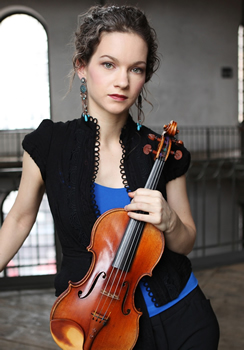North Carolina native and rising star Evan Rogister returned to Raleigh to conduct the North Carolina Symphony in concert with acclaimed violinist Hilary Hahn. The program featured works by Mozart, Schubert, and Weber and took place in Meymandi Concert Hall.
A tall, charming young man, Evan Rogister has been establishing himself as an opera conductor, both in Europe and the U.S. His recent appearances include Lyric Opera of Chicago, Washington National Opera, and the Houston Grand Opera, where he made his American debut in 2006.
Rogister cantered to the podium like a spring colt. He gathered himself for the opening piece, took a large breath, and launched Carl Maria Von Weber’s Overture to Oberon. His long limbs make for a wide reach, but his gestures were graceful and expressive. I wished that I could see him from the perspective of the orchestra, but clearly, Rogister knows how he wants every note to sound. And responding deftly to every detail, the orchestra sounded marvelous; providing the perfect beginning.
Schubert’s beloved Symphony No. 8 in B minor (“Unfinished”) was the centerpiece of the program. Abandoned after two movements (and fragments of a scherzo) Schubert’s work is, however, quite satisfying the way it stands and is recognized for its lyricism; it fit perfectly with Weber’s overture.
Rogister left no stone unturned, eliciting every dynamic and coloration. I wanted the low strings to hush at the outset of the first movement (Allegro moderato) but the cellos and basses played with gorgeous tone. Schubert’s sudden changes in dynamic and mood arrive like a thunderstorm. (Do I hear the influence of Beethoven?) For Rogister, the orchestra turned on a dime. The brasses were clear, the horns, mellow, and the violins, racing with fury, defied the laws of physics. The clarinet and oboe solos were exceptional.
A beautiful entry by the horns in the second movement (Andante con moto) gave me shivers. Schubert modulates to the parallel minor, stretches the rhythm into a marcato-like step and with every twist and turn, the orchestra followed the lead of the young conductor. A clarinet solo leads to a burst of sound; counterpoint adds to the tension, and finally we’re back to the beginning, this time with the oboe playing the solo. And when, at last, the orchestra played the coda, I was breathless. Anthony Burton writes, “[it] ends in a mood of almost unearthly serenity.”
Hilary Hahn is known for her fearless programming and more recently for her “encore” project. Disappointed, I had already resigned myself to her program choice, Concerto No. 5, in A Major, K.219 (1775), knowing that she would play the charming composition well. But turning spun gold out of Mozart’s lyrical phrases, Hahn’s playing was dazzling.
Performing in the midst of the reduced orchestra and in full view of the conductor, Hahn seemed to be part of an intimate soirée. The violinist took full advantage of the speed and Mozart’s mischievous figurations. Even the Adagio movement offers playful opportunities. The orchestra’s sinister chromatic passages of the Minuet make it feel like an operetta. Here, the violinist played the role of the “artful dodger.” Flirting with the violins, Hahn seized the attention of seasoned veterans who must have played the concerto a hundred times. Evan Rogister took her lead as he conducted with sensitivity. The orchestra responded in kind. Capturing Mozart’s youthful spirit, the musicians were nimble and light. Hahn’s cadenzas were crisp and clear; every note sang. This was music-making that moved us. Audience members rose to their feet.
For an encore, Hahn played the Gigue from J.S. Bach’s Partita No. 3. The audience offered hearty applause as she and her colleague Evan Rogister joined hands for a final bow.
Listen to Hilary Hahn talk about and play excerpts from her encore project here.











